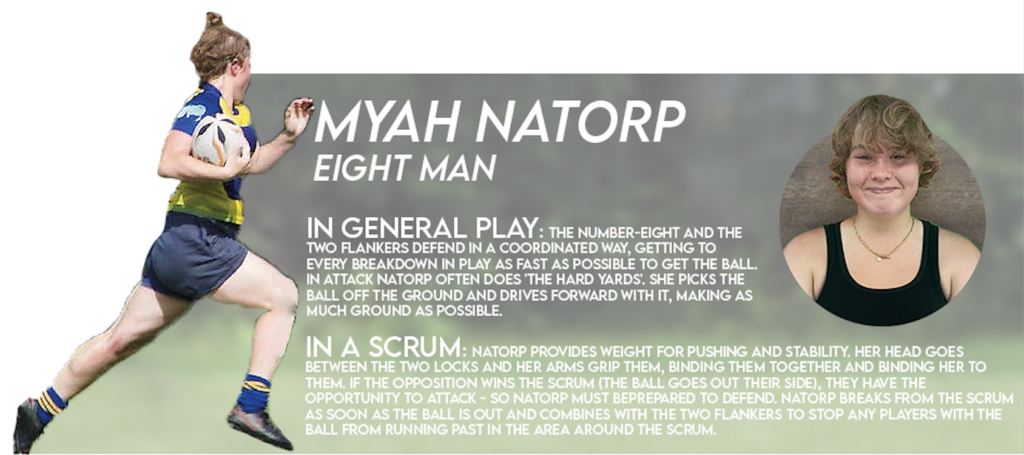Rugby provides outlet for Myah Natorp
Khusbu Patel | The Chronicle
Myah Natorp is not afraid to get dirty.
After watching football from the safety of her home, while players fought to hold the front lines, Sophomore Myah Natorp decided it was time to get herself involved in the action. Natorp had always wanted to be involved in the gritty combat of contact sports and found a way to the chaotic warfare through the world of rugby. Traveling to tournaments from Canada to California, Natorp’s life has been completely revolutionized by rugby. Natorp said she found her start in rugby when she visited Australia. However, her initial interest in the sport came from a uniquely American one: football.
“I had been begging my parents to let me play football, but they kept saying no,” Natorp said. “I’ve always thought playing a contact sport was cool and football was just the most popular one, but my mom was afraid of me [playing] because she didn’t want me to get a concussion.”
Both rugby and football are aggressive contact sports, but they differ when it comes to the way players play. Because there is no padding in rugby uniforms, opposing players hit with caution, and the rules dictate the harshness of a tackle. Rugby players are taught to use their arms and shoulders when tackling opponents and there are serious consequences for any contact above the shoulders. Natorp said this is one of the main reasons that far fewer concussions occur in rugby than they do in football.
“[In] rugby people don’t hit as recklessly,” Natorp said. “You can’t tackle above the shoulders and there’s an emphasis on correct tackle form [which reduces] concussions.”
In rugby, two teams of 15 players have 80 minutes to advance the ball past their opponents’ side of the field (called a pitch) and touch it to the ground for a score worth 5 points (called a try). Players may only pass the ball backwards or sideways with no blocking allowed, and the only way they can move the ball forward is by kicking it. Rugby is unique in that play is continuous even after players are tackled on the field. After each try, worth 5 points, the scoring team is allowed an opportunity to kick the ball through the posts for an additional 2 points (called a conversion).
Natorp plays the eight man in rugby and her role is to put in big tackles, carry the ball through the defensive line and provide support to the backs. Natorp said that one huge misconception is that rugby is just football without the pads, but that is far from the truth.
“[Even] when you don’t score or when you lose by 40 points, your whole team is still ecstatic that they even got to play because it’s such a genuinely fun sport,” Natorp said. “[Also] football [doesn’t have] as good sportsmanship as rugby, [therefore] I wouldn’t have the connections I do now.”

As Natorp began playing more, she fell in love with rugby. Because the sport is so rare in Cincinnati, however, Natorp usually has to travel 30 minutes to the nearest rugby facility in Walnut Hills just to practice. To play games, Natorp often has to go much farther to Cleveland or Columbus which makes it difficult to find many games per season. Traveling can be extremely time-consuming, which makes it hard for Natorp to balance rugby with school.
“Rugby has utterly consumed my life,” Natorp said. “Because we have to travel so much I end up doing my homework on the way to games which can be tiresome”.
Although playing rugby and managing school work can be difficult to work with at times, Natorp said rugby has helped her mentally. Mental strength is a necessity for rugby in order to outsmart the opposing team and execute smart plays. Natorp said the difficulty of rugby can act as a sort of escape from other stressors in her life.
“[Rugby is] a really good outlet for when I just need somewhere to go and be myself,” Natorp said. “I’ve also grown a lot of confidence through rugby because you have to be self-secured not only to tell your teammates what to do, but also be able to get back up and keep playing after you make a mistake.”
Rugby players often connect with each other through experiences provided by their programs. Teams have socials for players to get to know one another outside of the sport. Natorp said these events have helped push her out of her comfort zone and talk to new people.
“The rugby community helps me be open to everyone and not judge people immediately,” Natorp said.
Natorp, who has played on international rugby teams, said rugby connects people from all different backgrounds and helps break distance barriers. Natorp said these experiences have made her a more open and empathetic person because she gets to “learn so much about other girls’ lives and get a different perspective on how the world is.”
Natorp has been pushing to make this sport more common at MHS and she has finally gotten the sport to be listed with the other clubs in the school. Natorp said that the sport could thrive at MHS if people could overcome their initial nervousness.
“Even if you suck, you’re going to get better and meet people [who] are going to help you along the way,” Natorp said. “You’re going to make great connections that will boost your self-confidence. No matter what size you are, how you’re built, how fast or how strong you are, there’s always a position in rugby for you.”
Graphic by Allison Droege. Photo contributed by Myah Natorp
